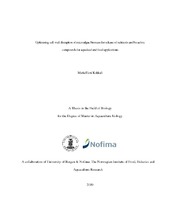| dc.description.abstract | Microalgae are photosynthetic organisms and primary producers of essential nutrients in the aquatic food chain. Although currently less exploited, microalgae culture can provide nutrients to cover the increasing demand for sustainable food production. Most microalgae possess hard cellulosic cell walls and cell wall integrity may significantly limit nutrient bioavailability for instance in farmed animals, such as fish, or in humans. Thus, preprocessing to disrupt the cell wall is necessary to facilitate nutrient release. The present study aimed to optimize cell wall disruption using bead milling for release of nutrients, such as lipids and proteins, and bioactive compounds, such as carotenoids and phenolic compounds, in Tetraselmis chuii and Phaeodactylum tricornutum. Bead type, level of algae dry matter, flow rate, tip speed, bead filling, and chamber volume were the tested bead milling parameters. Cell wall disruption efficiency was investigated for correlation with dry matter content, flow rate (as a measure of the retention time of the biomass in the milling chamber), and mill agitator tip speed. For Tetraselmis chuii, bead milling with glass beads (0.25-0.40 mm), resulted in 99% disruption of the biomass cells; whereas for Phaeodactylum tricornutum, bead milling with glass beads (0.25-0.40 mm), gave 75% disruption. In a following experiment, in which Zr beads (0.3mm) were used, the maximum disruption efficiency we achieved was approximately 13% higher for Phaeodactylum tricornutum. In the present study, we also show that fat and soluble protein release, increased by bead milling the microalgae biomass; while by bead milling, we also reduced the aerobic bacteria content of the processed biomass. iv Electropermeabilization treatment of the above microalgae biomasses with the use of Pulsed Electric Fields (PEF), as an alternative to conventional cell disruption methods was also tested. Electropermeabilization, the phenomenon in which, the cell membrane becomes permeable due to electricity, is affected by different PEF treatment parameters. In the present study, field strength of 1 and 3 kV/cm was applied, for extraction of bioactive compounds and measurement of total antioxidant capacity of T. chuii and P. tricornutum using different solvent (H2O and DMSO) and extraction time (4h and 24h). PEF treatment, extraction solvent and time affected significantly the tested variables (analyzed levels of chlorophyll a and b, total carotenoids, total antioxidant capacity and phenolic compounds) for both microalgae; with the exceptions of phenolic compounds released from P. tricornutum, and chlorophyll b released from T. chuii. Extraction of phenolic compounds was affected significantly by solvent and the interaction of solvent and PEF treatment. Last, the extraction levels of chlorophyll b were significantly affected by PEF treatment, extraction solvent and the interaction of extraction time and solvent. Keywords: Tetraselmis chuii, Phaeodactylum tricornutum, cell wall disruption, bead milling, pulse electric fields (PEF), chlorophyll, carotenoids, soluble proteins, EPA, DHA, phenolic compounds, total antioxidant capacity. | en_US |
